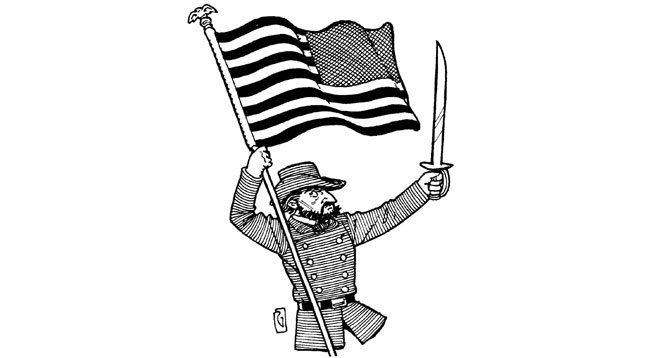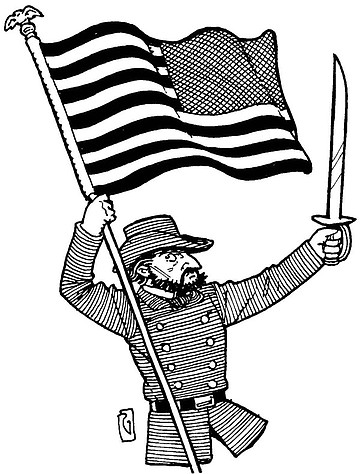 Facebook
Facebook
 X
X
 Instagram
Instagram
 TikTok
TikTok
 Youtube
Youtube

Hi Matt!
I’ve noticed, since at least the first Gulf War, the flag patches on the uniforms of American soldiers are backwards. To me, that’s weird. What’s the story? Nobody I know can fill me in. Why backward American flag? I’m no super patriot and don’t care one way or the other, but I’m curious why the flag is backwards. — Vic, North Park

You’re only looking at soldiers’ right arms, Vic. That patch has the flag “backwards.” If you get the soldier to stand still and you walk around him/her to the left side and look at that arm, you’ll see yet another flag, and this one looks “correct.”
Yep, official flag etiquette sez the blue field on a flat, two-dimensional image of the American flag must be on the left. On a flagpole, the blue field must be closest to the pole. So, it’s a brisk day; red-white-and-bluie is snapping sharply in the breeze. Stand to the left of the flag, the blue field is “correct,” to the left, close to the pole. Hop around to the other side, to the right, and the flag looks “incorrect,” with the blue field still closest to the pole but on the “incorrect” side of the flag image. So we even have real live flags part “right” and part “wrong.”
As for your specific Army patch question, though, we’re not quite through. Of course the Army could have made both patches blue-field-left on both sleeves. But here’s their reasoning, according to the Department of Defense: Way back in the day, the infantry and cavalry fought as a mass of soldiers charging forward to meet the opposing mass of soldiers. Each side had a standard bearer, one man who carried their flag into battle. The flag streamed gloriously from the flagpole as they attacked. Therefore, the patches on contemporary sleeves replicate that “forward into battle” image; think of the soldier as the flagpole. That’s what the patch configuration represents. Using their reasoning, a blue-field-left patch on the right sleeve would indicate retreat. Patch placement is codified in Army Regulation 670-1. Apparently there are even soldiers who don’t know the answer to your question. The DOD works in mysterious ways.
Heymatt:
What the heck is aggravated murder rather than regular murder? I think anybody who kills somebody would have to be pretty aggravated. So why isn’t every murder aggravated murder?
— I’m Innocent, I’m from Carlsbad, and I Want My Attorney
Yeah. What’s up with that? And what’s felony murder? Implies there’s a thing called misdemeanor murder. Give a lawyer a pencil and paper and things eventually get confusing for the rest of us. Used to be, you offed a guy, we offed you. But the U.S. was hardly ten years old before we started tweaking the murder laws to account for self-defense and the like. But by the early 1970s there were rumblings that the death penalty was being arbitrarily applied across the country, and states started defining the circumstances of a murder that warranted the death penalty or life without parole. Thirty-six states have their own lists of special circumstances. California’s list has 21 of them. And just for clarification, these circumstances apply during the penalty phase of a trial, for someone who has already been convicted of first-degree murder. It’s the special circumstances that will help decide life without or death. Murder without special circumstances (unaggravated murder?) also includes, as a possible penalty, 15 years to life in prison (life with the possibility of parole). Got it? Hope so. We’re moving on.
Herewith, a casual summary of aggravating circumstances, California style. Murder for monetary gain. Murder by someone previously convicted of first- or second-degree murder. Hiding a bomb, or mailing or delivering a bomb. To avoid arrest. Victim is a law/peace officer, fireman, prosecutor, judge, juror, elected/appointed official, any of whom are carrying out their duties or in retaliation for having done so. Witness to a crime killed to stop testimony or retaliate for testimony. Murder especially cruel, depraved, torturous. Lying in wait for victim. Hate crime. Murder associated with any of 12 felonies (including rape, robbery, burglary, arson, kidnapping, carjacking, lewd acts on a child under 14). Murder by poison. Drive-bys. Murder by active criminal street gang member on behalf of the gang. Anyone who hires, aids, abets, or otherwise hangs out with a convicted murderer in connection with his crime of murder.
I’m not a lawyer, and I don’t play one on TV, but it looks to me that if you shoot your aggravating spouse, you might avoid the ultimate punishment. Poison him/her, and your odds aren’t so good. Murder by poison is aggravated murder (or “murder with special circumstances”). A simple shooting is not. But please don’t tear out this column and take it with you to court, then file a lawsuit against me from your bunk on death row. I am not a lawyer. I do not play one on TV.


Hi Matt!
I’ve noticed, since at least the first Gulf War, the flag patches on the uniforms of American soldiers are backwards. To me, that’s weird. What’s the story? Nobody I know can fill me in. Why backward American flag? I’m no super patriot and don’t care one way or the other, but I’m curious why the flag is backwards. — Vic, North Park

You’re only looking at soldiers’ right arms, Vic. That patch has the flag “backwards.” If you get the soldier to stand still and you walk around him/her to the left side and look at that arm, you’ll see yet another flag, and this one looks “correct.”
Yep, official flag etiquette sez the blue field on a flat, two-dimensional image of the American flag must be on the left. On a flagpole, the blue field must be closest to the pole. So, it’s a brisk day; red-white-and-bluie is snapping sharply in the breeze. Stand to the left of the flag, the blue field is “correct,” to the left, close to the pole. Hop around to the other side, to the right, and the flag looks “incorrect,” with the blue field still closest to the pole but on the “incorrect” side of the flag image. So we even have real live flags part “right” and part “wrong.”
As for your specific Army patch question, though, we’re not quite through. Of course the Army could have made both patches blue-field-left on both sleeves. But here’s their reasoning, according to the Department of Defense: Way back in the day, the infantry and cavalry fought as a mass of soldiers charging forward to meet the opposing mass of soldiers. Each side had a standard bearer, one man who carried their flag into battle. The flag streamed gloriously from the flagpole as they attacked. Therefore, the patches on contemporary sleeves replicate that “forward into battle” image; think of the soldier as the flagpole. That’s what the patch configuration represents. Using their reasoning, a blue-field-left patch on the right sleeve would indicate retreat. Patch placement is codified in Army Regulation 670-1. Apparently there are even soldiers who don’t know the answer to your question. The DOD works in mysterious ways.
Heymatt:
What the heck is aggravated murder rather than regular murder? I think anybody who kills somebody would have to be pretty aggravated. So why isn’t every murder aggravated murder?
— I’m Innocent, I’m from Carlsbad, and I Want My Attorney
Yeah. What’s up with that? And what’s felony murder? Implies there’s a thing called misdemeanor murder. Give a lawyer a pencil and paper and things eventually get confusing for the rest of us. Used to be, you offed a guy, we offed you. But the U.S. was hardly ten years old before we started tweaking the murder laws to account for self-defense and the like. But by the early 1970s there were rumblings that the death penalty was being arbitrarily applied across the country, and states started defining the circumstances of a murder that warranted the death penalty or life without parole. Thirty-six states have their own lists of special circumstances. California’s list has 21 of them. And just for clarification, these circumstances apply during the penalty phase of a trial, for someone who has already been convicted of first-degree murder. It’s the special circumstances that will help decide life without or death. Murder without special circumstances (unaggravated murder?) also includes, as a possible penalty, 15 years to life in prison (life with the possibility of parole). Got it? Hope so. We’re moving on.
Herewith, a casual summary of aggravating circumstances, California style. Murder for monetary gain. Murder by someone previously convicted of first- or second-degree murder. Hiding a bomb, or mailing or delivering a bomb. To avoid arrest. Victim is a law/peace officer, fireman, prosecutor, judge, juror, elected/appointed official, any of whom are carrying out their duties or in retaliation for having done so. Witness to a crime killed to stop testimony or retaliate for testimony. Murder especially cruel, depraved, torturous. Lying in wait for victim. Hate crime. Murder associated with any of 12 felonies (including rape, robbery, burglary, arson, kidnapping, carjacking, lewd acts on a child under 14). Murder by poison. Drive-bys. Murder by active criminal street gang member on behalf of the gang. Anyone who hires, aids, abets, or otherwise hangs out with a convicted murderer in connection with his crime of murder.
I’m not a lawyer, and I don’t play one on TV, but it looks to me that if you shoot your aggravating spouse, you might avoid the ultimate punishment. Poison him/her, and your odds aren’t so good. Murder by poison is aggravated murder (or “murder with special circumstances”). A simple shooting is not. But please don’t tear out this column and take it with you to court, then file a lawsuit against me from your bunk on death row. I am not a lawyer. I do not play one on TV.
Comments